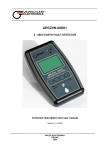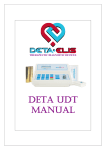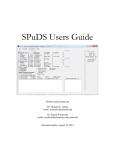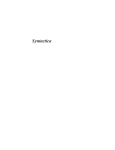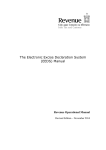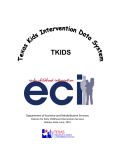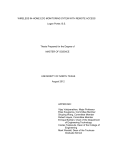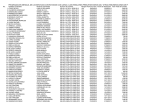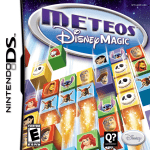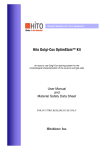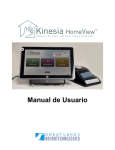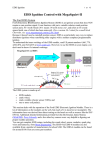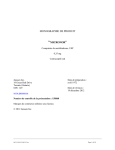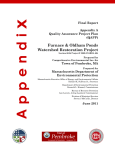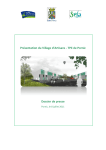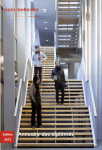Download FD Rapid GolgiStain™ Kit
Transcript
Quality & Excellence Since 1996 FD Rapid GolgiStain™ Kit A complete Golgi-Cox staining system for the study of the morphology of neurons and glia User Manual (PK 401, Version 2006-02) FOR IN VITRO RESEARCH USE ONLY not for diagnostic or other uses FD NeuroTechnologies, Inc. P.O. Box 785, Ellicott City, MD 21041, U.S.A. Phone: 410-788-1864 FAX: 410-788-1171 www.fdneurotech.com 2002-2006 FD NeuroTechnologies Consulting & Services, Inc. All Rights Reserved Contents I. Introduction ..................................................................... 3 II. Kit Contents................................................................................................................ 3 III. Materials Required but Not Included ........................................................................ 3 IV. Safety and Handling Precautions .............................................................................. 4 V. Tissue Preparation ..................................................................................................... 4 VI. Staining Procedure .................................................................................................... 6 VII. References............................................................................................................7 2 I. Introduction Golgi-Cox impregnation1, 2 has been one of the most effective techniques for studying both the normal and abnormal morphology of neurons as well as glia. Using the Golgi technique, subtle morphological alterations in neuronal dendrites and dendritic spines have been discovered in the brains of animals treated with drugs as well as in the postmortem brains of patients with neurological diseases3, 4. However, the reliability and time-consuming process of Golgi staining have been major obstacles to the widespread application of this technique. FD Rapid GolgiStain™ kit is designed based on the principle of the methods described by Ramón-Moliner2 and Glaser and Van der Loos5. This kit has not only dramatically improved and simplified the Golgi-Cox technique but has also proven to be extremely reliable and sensitive for demonstrating morphological details of neurons and glia, especially dendritic spines. The FD Rapid GolgiStain™ kit has been tested extensively on the brains from several species of animals as well as on the specimens of postmortem human brains (for photo samples and references using this kit, please visit our web site at www.fdneurotech.com). II. Kit Contents Store at room temperature Solution A Solution B Solution C Solution D Solution E Glass Specimen Retriever Natural hair paintbrush Dropping bottle Plastic forceps User Manual 250 ml 250 ml 250 ml x 2 250 ml 250 ml 2 3 1 1 1 III. Materials Required but Not Included 1. 2. Double distilled or deionized water Plastic/glass tubes or vials 3 3. Histological supplies and equipment: Gelatin-coated microscope slides • Coverslips • Staining jars • Ethanol • Xylene or xylene substitutes • Resinous mounting medium (e.g. Permount®) • A light microscope. • Permount® is a registered trademark of Fisher Scientific. IV. Safety and Handling Precautions* 1. FD Rapid GolgiStain™ kit is made for in vitro research use only and not for drug, diagnostic or other uses. 2. The kit contains reagents that are toxic and harmful in contact with skin or by inhalation and may be fatal if ingested. Do not pipette by mouth. Avoid inhalation and contact with skin and eyes. In case of contact, wash immediately with generous amounts of water and seek medical advice. If swallowed, wash out mouth with water and immediately call a physician. 3. Perform experiment under a chemical hood. Wear suitable protective clothing, gloves and eye/face protection while handling kit reagents. Wash hands thoroughly after performing the experiment. *Material safety data sheet (MSDS) is available at www.fdneurotech.com. V. Tissue Preparation • • • • • All containers (plastic preferred) to be used should be cleansed and rinsed with distilled water. Do not use metal implements whenever Solutions A and B are present. Keep containers tightly closed at all times. All tissues treated with Solutions A and B, including tissue sections should be protected from light. The following procedure should be performed at room temperature unless specifically indicated. Note FD Rapid GolgiStain™ kit has been proven to produce the best results in animal and postmortem human brain tissues prepared according to the following procedures. However, it may be used in tissue specimens prepared differently (please contact FD NeuroTechnologies for more information before use). 4 1. Experimental animals should be deeply anesthetized before killing. The animal brain (or postmortem human specimens) should be removed from the skull as quickly as possible but handled carefully to avoid damage or pressing of the tissue. Note • • Perfusion of animals and fixation of tissue are not necessary. Large brain specimens should be sliced with a sharp blade into blocks of approximately 10 mm thickness. 2. Rinse tissue briefly in double distilled water to remove blood from the surface. 3. Immerse tissue in the impregnation solution, made by mixing equal volumes of Solutions A and B, and store at room temperature for 2 weeks in the dark*. Replace the impregnation solution after first 6 hours of immersion or on next day. * A 2-week impregnation time is satisfactory in most cases. However, variations in type and actual size of tissue may require a shorter or longer duration of impregnation to obtain the best results. The ideal time should be obtained by trial for each type of tissue, but 3 weeks is often sufficient for most tissues. Note that prolonging the impregnation time may cause non-specific staining. Note • • • • The mixture of Solution A and B should be prepared at least 24 hours prior to use and left unstirred. It is important to use the top part of solution that is free of precipitate. The impregnation solution may be stored at room temperature for up to 1 month in the dark before use. Use at least 5 ml of the impregnation solution for each cubic cm of the tissue to be studied (i.e., the volume of the impregnation solution should be at least five times that of the tissue). Note that use a lesser volume of impregnation solution may decrease the sensitivity and reliability of staining. Warning: Solutions A (containing potassium dichromate and mercuric chloride) and B (containing potassium chromate) are toxic in contact with skin and may be fatal if swallowed. The experiment should be performed under a chemical hood. Wear suitable protective clothing, gloves and eye/face protection while handling the reagents. DO NOT POUR THE WASTE OF SOLUTIONS A AND B INTO THE SINK. Collect the waste of these solutions in a bottle and call your safety office or a licensed professional waste disposal service to dispose of this material. 4. Transfer tissue into Solution C and store at 4ºC for at least 48 hours (up to 1 week) in the dark. Replace the solution after first 24 hours of immersion or on next day. 5 5. Sections (up to 240 µm thickness) may be cut slowly on a cryostat (or a similar type of microtome) with the chamber temperature set at -22°C. Each section should then be transferred with a glass specimen retriever (provided) and mounted with Solution C on gelatin-coated microscope slides (a dropping bottle is provided for easy dropping of Solution C onto the slides). After absorption of excess solution left on slide with a strip of filter paper, sections should be naturally dried at room temperature (do not use a fan or hot plate). Dried sections should be processed as soon as possible but may be stored in a slide box at room temperature for a week in the dark. Note • To prevent tissue from ice crystal damage and to preserve the best possible cell morphology, tissue should be frozen rapidly before sectioning with a cryostat, e.g. by immersing the tissue in isopentane precooled to –70°C with dry ice. • The types of cryostat may vary, but all types should be able to cut thick sections (e.g. 100 µm). Contact FD NeuroTechnologies for technical assistance. • The –22°C setting of temperature for the cryostat chamber is satisfactory in most cases. However, variations in type of cryostat and tissue may require a higher or lower chamber temperature in order to cut sections smoothly and without shattering. VI. Staining Procedure 1. Rinse sections in distilled water 2 times, 2 minutes each. 2. Place sections in a mixture consisting of 1 part Solution D, 1 part Solution E and 2 parts double distilled water for 10 minutes. e.g. Solution D Solution E Distilled water 10 ml 10 ml 20 ml Note • • • The working solution should be prepared just before use and may be used for up to 100 sections per 100 ml. The bottle and staining jar containing the working solution must be covered to prevent vaporization of the reagent. For the best results, the working solution should be stirred frequently during incubation. 3. Rinse sections in distilled water 2 times, 4 minutes each (distilled water should be renewed frequently). 4. Counterstain sections with cresyl violet or thionin (optional step). 6 5. Dehydrate sections in 50%, 75% and 95% ethanol, 4 minutes each (do not skip any step). 6. Dehydrate sections in absolute ethanol, 4 times, 4 minutes each (do not prolong). 7. Clear in xylene or xylene substitutes, 3 times, 4 minutes each, and coverslip in resinous mounting medium (e.g. Permount®). Note • • For the best results, use undiluted mounting medium. Golgi-stained sections should be protected from light whenever possible. VII. References 1. Corsi P: Camillo Golgi’s morphological approach to neuroanatomy. In Masland RL, Portera-Sanchez A and Toffano G (eds.), Neuroplasticity: a new therapeutic tool in the CNS pathology, pp 1-7. Berlin: Springer, 1987. 2. Ramón-Moliner E: The Golgi-Cox technique. In Nauta WJH and Ebbesson SOE (eds.), Contemporary Methods in Neuroanatomy. pp 32-55, New York: Springer, 1970. 3. Graveland GA, Williams RS and DiFiglia M: Evidence for degenerative and regenerative changes in neostriatal spiny neurons in Huntington’s disease. Science 227:770-773, 1985. 4. Robinson TE and Kolb B: Persistent structural modification in nucleus accumbens and prefrontal cortex neurons produced by previous experience with amphetamine. J. Neurosci. 17:8491-8497, 1997. 5. Glaser ME and Van der Loos H: Analysis of thick brain sections by obverse-reverse computer microscopy: application of a new, high clarity Golgi-Nissl stain. J. Neurosci. Methods 4:117-125, 1981. References using this kit: 1. Dahl JP, Wang-Dunlop J, Gonzales C, Goad MEP, Mark RJ and Kwak SP: Characterization of the WAVE1 knock-out mouse: implications for CNS development. J. Neuroscience 23: 3343-3352, 2003. 2. Beggs HE, Schahin-Reed D, Zang K, Goebbels S, Nave KA, Gorski J, Jones KR, Sretavan D and Reichardt LF: FAK deficiency in cells contributing to the basal lamina results in cortical abnormalities resembling congenital muscular dystrophies. Neuron 40:501-514, 2003. 3. Milatovic D, Zaja-Milatovic S, Montine KS, Horner PJ, and Montine TJ: Pharmacologic suppression of neuronal oxidative damage and dendritic degeneration following direct activation of glial innate immunity in mouse cerebrum. J. Neurochem. 87: 1518-1526, 2003. 4. Amateau SK and McCarthy MM: Induction of PGE2 by estradiol mediates developmental masculinization of sex behavior. Nature Neuroscience 7:643-650, 2004. 5. Ishikura N, Clever JL, Bouzamondo-Bernstein E, Samayoa E, Prusiner SB, Huang EJ, and DeArmond SJ: Notch-1 activation and dendritic atrophy in prion disease. Proc. Natl. Acad. Sci. USA 102:886-891, 2005. 7 6. Ren-Patterson RF, Cochran LW, Holmes A, Sherrill S, Huang SJ, Tolliver T, Lesch KP, Lu B and Murphy DL: Loss of brain-derived neurotrophic factor gene allele exacerbates brain monoamine deficiencies and increases stress abnormalities of serotonin transporter knockout mice. J. Neurosci. Res. 79:756-771, 2005. 7. Grillet N, Pattyn A, Contet C, Kieffer BL, Goridis C and JF Brunet: Generation and characterization of Rgs4 mutant mice. Molecular and Cellular Biology 25:4221-4228, 2005. 8. Laub F, Lei L, Sumiyoshi H, Kajimura D, Dragomir C, Smaldone S, Puche AC, Petros TJ, Mason C, Parada LF, and Ramirez F: Transcription factor KLF7 is important for neuronal morphogenesis in selected regions of the nervous system. Molecular and Cellular Biology 25:5699-5711, 2005. 9. McLaughlin KJ, Baran SE, Wright RL and Conrad CD: Chronic stress enhances spatial memory in ovariectomized female rats despite CA3 dendritic retraction: possible involvement of CA1 neurons. Neuroscience 135:1045-1054, 2005. 10. Pyter LM, Reader BF and Nelson RJ: Short photoperiods impair spatial learning and alter hippocampal dendritic morphology in adult male white-footed mice (peromyscus leucopus). J. Neuroscience 25:4521-4526, 2005. 11. Björkblom B, Östman N, Hongisto V, Komarovski V, Filén JJ, Nyman TA, Kallunki T, Courtney MJ and Coffey ET: Constitutively active cytoplasmic c-jun N-terminal kinase 1 is a dominant regulator of dendritic architecture: role of microtubule-associated protein 2 as an effector. J. Neuroscience 25:6350-6361, 2005. 12. Niewmierzycka A, Mills J, St-Arnaud R, Dedhar S and Reichardt LF: Integrin-linked kinase deletion from mouse cortex results in cortical lamination defects resembling cobblestone lissencephaly. J. Neuroscience 25:7022-7031, 2005. 13. Gu X, Li C, Wei W, Lo V, Gong S, Li SH, Iwasato T, Itohara S, Li XJ, Mody I, Heintz N and Yang XW: Pathological cell-cell interactions elicited by a neuropathogenic form of mutant huntingtin contribute to cortical pathogenesis in HD mice. Neuron 46:433-444, 2005. 14. Ramanan N, Shen Y, Sarsfield S, Lemberger T, Schütz G, Linden DJ and Ginty DD: SRF mediates activity-induced gene expression and synaptic plasticity but not neuronal viability. Nature Neuroscience 8:759-767, 2005. 15. Moretti P, Levenson JM, Battaglia F, Atkinson R, Teague R, Antalffy B, Armstrong D, Arancia O, Sweatt JD and Zoghbi HY: Learning and memory and synaptic plasticity are impaired in a mouse model of Rett syndrome. J. Neuroscience 26:319-327, 2006. 16. Inan M, Lu HC, Albright MJ, She WC and Crair MC: Barrel map development relies on protein kinase A regulatory subunit II β-mediated cAMP signaling. J. Neuroscience 26:4338-4349, 2006. 17. Jacobsen JS, Wu CC, Redwine JM, Comery TA, Arias R, Bowlby M, Martone R, Morrison JH, Pangalos, MN, Reinhart PH and Bloom FE: Early-onset behavioral and synaptic deficits in a mouse model of Alzheimer's disease. Proc. Natl. Acad. Sci. USA 103:5161-5166, 2006. For more references using this kit, please visit our website at www.fdneurotech.com. (Updated 05/31/06) 8









